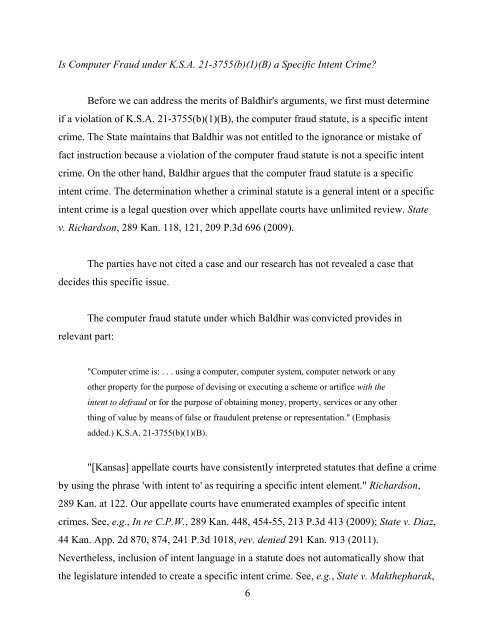Kansas Court of Appeals - 105930 â State v. Sood
Kansas Court of Appeals - 105930 â State v. Sood
Kansas Court of Appeals - 105930 â State v. Sood
Create successful ePaper yourself
Turn your PDF publications into a flip-book with our unique Google optimized e-Paper software.
Is Computer Fraud under K.S.A. 21-3755(b)(1)(B) a Specific Intent Crime?<br />
Before we can address the merits <strong>of</strong> Baldhir's arguments, we first must determine<br />
if a violation <strong>of</strong> K.S.A. 21-3755(b)(1)(B), the computer fraud statute, is a specific intent<br />
crime. The <strong>State</strong> maintains that Baldhir was not entitled to the ignorance or mistake <strong>of</strong><br />
fact instruction because a violation <strong>of</strong> the computer fraud statute is not a specific intent<br />
crime. On the other hand, Baldhir argues that the computer fraud statute is a specific<br />
intent crime. The determination whether a criminal statute is a general intent or a specific<br />
intent crime is a legal question over which appellate courts have unlimited review. <strong>State</strong><br />
v. Richardson, 289 Kan. 118, 121, 209 P.3d 696 (2009).<br />
The parties have not cited a case and our research has not revealed a case that<br />
decides this specific issue.<br />
relevant part:<br />
The computer fraud statute under which Baldhir was convicted provides in<br />
"Computer crime is: . . . using a computer, computer system, computer network or any<br />
other property for the purpose <strong>of</strong> devising or executing a scheme or artifice with the<br />
intent to defraud or for the purpose <strong>of</strong> obtaining money, property, services or any other<br />
thing <strong>of</strong> value by means <strong>of</strong> false or fraudulent pretense or representation." (Emphasis<br />
added.) K.S.A. 21-3755(b)(1)(B).<br />
"[<strong>Kansas</strong>] appellate courts have consistently interpreted statutes that define a crime<br />
by using the phrase 'with intent to' as requiring a specific intent element." Richardson,<br />
289 Kan. at 122. Our appellate courts have enumerated examples <strong>of</strong> specific intent<br />
crimes. See, e.g., In re C.P.W., 289 Kan. 448, 454-55, 213 P.3d 413 (2009); <strong>State</strong> v. Diaz,<br />
44 Kan. App. 2d 870, 874, 241 P.3d 1018, rev. denied 291 Kan. 913 (2011).<br />
Nevertheless, inclusion <strong>of</strong> intent language in a statute does not automatically show that<br />
the legislature intended to create a specific intent crime. See, e.g., <strong>State</strong> v. Makthepharak,<br />
6

















